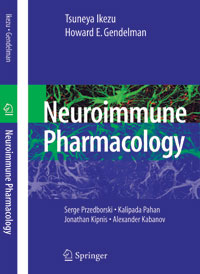 Three years ago when the department of pharmacology merged with the Center for Neurovirology and Neurodegenerative Disorders to become the UNMC Department of Pharmacology and Experimental Neuroscience, there were a lot of questions about the connection between neuroscience, immunology and pharmacology.
Three years ago when the department of pharmacology merged with the Center for Neurovirology and Neurodegenerative Disorders to become the UNMC Department of Pharmacology and Experimental Neuroscience, there were a lot of questions about the connection between neuroscience, immunology and pharmacology.
During the course of that time considerable progress was made to make that connection clearer in the form of new course offerings, the establishment of a new journal and now a textbook that serves to combine the three fields.
Neuroimmune Pharmacology is the first book that extensively integrates historically separate fields of research into a cohesive, interdisciplinary and comprehensive resource for students and educators.
All three fields of research — neuroscience, immunology and pharmacology — have major translational implications for a number of neurodegenerative, neuroinflammatory and neuropsychiatric diseases, as well as infections of the nervous system, said Phil Peterson, Ph.D., past president of the Society on NeuroImmune Pharmacology.
“This book will serve as a definitive resource for all students and researchers interested in the various topics that are so well covered in it,” he said.
The book is edited by UNMC researchers Tsuneya Ikezu, M.D., Ph.D., and Howard Gendelman, M.D., chairman of the department of pharmacology and experimental neuroscience with help from a broad range of associate editors, including Serge Przedborski, Ph.D., of Columbia University, Kalipada Pahan, Ph.D., from Rush University Medical Center, and UNMC researchers Jonathan Kipnis, Ph.D., and Alexander Kabanov, Ph.D., who have a range of expertise in neuroimmunology, neuroprotection, nanomedicine, neurotoxicology, and neurodegenerative disorders.
The comprehensive work, which was managed by Robin Taylor — who also serves as managing editor of the Journal of Neuroimmune Pharmacology based at UNMC — will be published by Springer Science in late 2007.
The textbook is rich in information on how the immune system both protects the body against a plethora of harmful microbial pathogens and at the same time can be an impediment to therapy.
It delves into the field of neuroscience and the inner workings of the nervous system, the cells that make up the different regions, their networks and modes of communication in health and disease.
And it explores the pharmacology of the various drug therapies currently available and how they affect human health and behavior and those therapies still in discovery at the bench.
“In the past two decades enormous strides have been made in our understanding of the relationship between inflammation, innate immune responses, adaptive immune responses and degenerative human diseases, but the developing information has mostly appeared in specialty journals that have dealt only with isolated aspects of these tightly related fields,” writes Patrick McGeer, professor emeritus in the Kinsmen laboratory of Neurological Research at the University of British Columbia, in the preface. “As a result, contemporary scientists have had a difficult time finding sources, even in review articles, that provide an integrated picture. This volume, by assembling chapters that demonstrate the relationship between these historically separated fields, overcomes that difficulty.”
“We believe that new discoveries can and will be made through the intersections of neuroscience, immunology and pharmacology and sought to define it for the student,” Drs. Gendelman and Ikezu wrote in the introduction.
The impetus for Neuroimmune Pharmacology began in December of 2003 when a new graduate course for neuroimmunology was developed, Dr. Ikezu said.
“This proved highly successful and laid the foundation and organization of the current textbook. … This book defines not only the new academic field itself but also the national status of our group,” he said. “I am humbled by the realization of this singular accomplishment.”